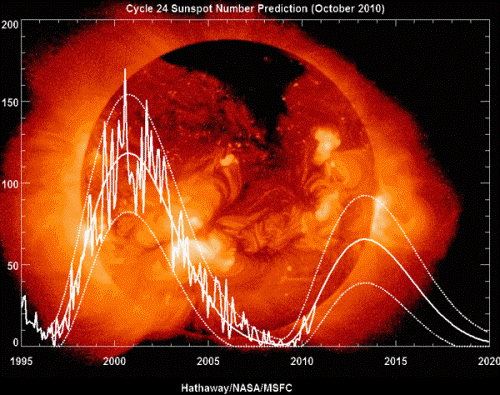 At 1600 times the distance between the Milky Way and our nearest galactic neighbor (the Andromeda Galaxy), the super cluster of quasars (quasi-stellar radio sources) spans 4 billion light years along its widest dimension (i.e., it would take light 4 billion years to traverse its widest dimension).
At 1600 times the distance between the Milky Way and our nearest galactic neighbor (the Andromeda Galaxy), the super cluster of quasars (quasi-stellar radio sources) spans 4 billion light years along its widest dimension (i.e., it would take light 4 billion years to traverse its widest dimension).
Such large quasar groups (LQGs) are the largest structures that can be seen dating from the early universe; in this case, light from the original quasars in this group commenced almost 9 billion years ago (or when the universe was just 5 billion years old).
LQGs are typically comprised of anywhere from 5 to 40 member quasars, with the largest (previously found) being 70 to 350 megaparsecs (Mpc)* in size.
But this newest, “most extreme” LQG — found amongst the millions of images in the DR7QSO Sloan Digital Sky Survey (SDSS) — measures some 500 Mpc in its shortest dimension and 1240 Mpcs in its widest dimension. It has 73 member quasars.
The structure has been dubbed U1.27 (where ‘U’ stands for the connected unit of quasars, and the number refers to the mean redshift; oldest quasars have a red shift value of ≥6).
In fact, U1.27 is so large that it would seem to violate Einstein’s cosmological principle which asserts that, at large scales (such as measured in this LQG discovery), the universe should look the same no matter the direction or locale from which one looks.
So, according to that principle, astronomers calculated that such large-scale structures should be no larger than 1.2 billion light years across. The newly discovered LQG is, on average, 1.63 billion light years across (note: the measurement variability in its dimensions is due to its irregular shape).

In 2010, astronomers Yadav, Bagla & Khandai devised a “scale of homogeneity” with which to compare/measure such structures in respects to the concordance cosmology (i.e., their concordance, or agreement, with the cosmological principle). Previous discoveries of LQGs were only “marginally compatible” with this scale.
According Clowes et al (quoting from the published paper abstract):
“This new, Huge-LQG appears to be the largest structure currently known in the early Universe. Its size suggests incompatibility with the Yadav et al. scale of homogeneity for the concordance cosmology, and thus challenges the assumption of the cosmological principle.”
It may likely be the first time that Einstein has been proven wrong.
* A parsec is a unit of length used in astronomy, equal to about 30.9 trillion kilometres (19.2 trillion miles). In astronomical terms, it is equal to 3.26 light-years, and in scientific terms it is equal to 3.09×1013 kilometres (1.92×1013 miles).
The findings were recently published in Monthly Notices of the Royal Astronomical Society under the title ‘A structure in the early Universe at z ∼ 1.3 that exceeds the homogeneity scale of the R-W concordance cosmology’
The researchers responsible for the discovery are: Roger G. Clowes,Kathryn A. Harris, Srinivasan Raghunathan, Luis E. Campusano, Ilona K. Söchting, and Matthew J. Graham
Some source material for this post came from the Science NOW article:ScienceShot: The Largest Structure in the Universe by Sid Perkins
Top Image: (note: image is NOT of the UI.27 LQG) Quasars Acting as Gravitational Lenses. To find these cases of galaxy–quasar combinations acting as lenses, astronomers selected 23.000 quasar spectra from the SDSS); credit: NASA, ESA/Hubble and F. Courbin (Ecole Polytechnique Federale de Lausanne, Switzerland; CC – By 3.0


Sorry, this is not the first time Einstein has been proven wrong. See Ohanian’s book Einstein’s Mistakes for a list of some doozies. Take Einstein off his pedestal – he never wanted to be on it.
No one claims he was perfect, or was 100% right all the time. No one should assume so. But probably no other person advanced science as much as he did in recent centuries.
It doesn’t seem as though the author takes a condescending tone toward Einstein at all. It was well-written and focused properly on the LQG, not on Einstein.
Sorry, this is not the first time Einstein has been proven wrong. See Ohanian’s book Einstein’s Mistakes for a list of some doozies. Take Einstein off his pedestal – he never wanted to be on it.
No one claims he was perfect, or was 100% right all the time. No one should assume so. But probably no other person advanced science as much as he did in recent centuries.
So this super quasar is red-shifted which means it’s moving away from earth. How much time has passed for the light from this cluster to reach earth and be observed? The reason I ask is that if that cluster is still expanding it would actually be bigger than it is being observed at this time.
So this super quasar is red-shifted which means it’s moving away from earth. How much time has passed for the light from this cluster to reach earth and be observed? The reason I ask is that if that cluster is still expanding it would actually be bigger than it is being observed at this time.
Thanks for your comment/question. Well, as astronomers have calculated that this super cluster of quasars formed about 5 billion years after the BB, and the universe is about 13.7 billion years old…so, it would take light about 8.7 billion years to reach us..so, yes, your observation is probably quite true — the cluster is probably larger than at present (and it may even have ‘birthed’ new stars/quasars too.)
Deep space astronomy is always and forever a catch up game with cosmological time (distance).